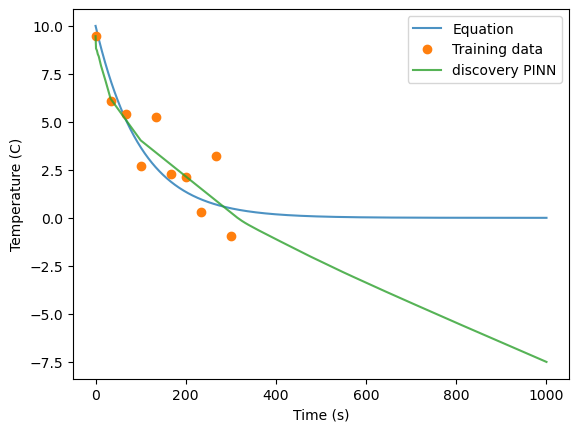4.2 Physics-Informed Neural Networks
Contents
4.2 Physics-Informed Neural Networks#
In the physical sciences, we may already have physical models to explain observations. The fundamental principle in PINNs trains a neural network that is physis-agnostic at initial design, but constraining the predictions to obey physical law by crafting the loss function accordingly.
We will take the simple example of the heat diffusion in 1D. The tutorial below is inspired by https://github.com/TheodoreWolf/pinns.
import functools
import matplotlib.pyplot as plt
import numpy as np
import torch
import scipy
import torch.nn as nn
import torch.optim as optim
DEVICE = torch.device('cuda' if torch.cuda.is_available() else 'cpu')
torch.manual_seed(42)
np.random.seed(10)
We write a simple Ordinay Differential Equation:
\( \frac{dT}{dt} (t) = r (T_1 - T(t)) \),
Where \(r\) is a rate of temperature change (cooling or heating), \(T_1\) is the final - ambient temperature.
Provided the initial condition that \(T(t=0) = T_0 \), a theoretical solution to this equation, we write the theoretical temperature field:
\( T(t) = (T_0-T_1) \exp(-rt) +T_1 \).
We will create this solution using a simple neural network. Given the theoretical solution, we can create synthetic data:
First, we create synthetic, toy, noisy data.
def cooling_law(time, Tenv, T0, R):
T = Tenv + (T0 - Tenv) * np.exp(-R * time) #
return T
Using cooling_law, we create synthetic data and noise.
Tenv = 0
T0 = 10
R = 0.01
times = np.linspace(0, 1000, 1000)
eq = functools.partial(cooling_law, Tenv=Tenv, T0=T0, R=R ) # add comments
temps = eq(times)
# Make training data
t = np.linspace(0, 300, 10)
T = eq(t) + 2 * np.random.randn(10)
plt.plot(times, temps)
plt.plot(t, T, 'o')
plt.legend(['Equation', 'Training data'])
plt.ylabel('Temperature (C)')
plt.xlabel('Time (s)')
plt.grid(True)
Text(0.5, 0, 'Time (s)')
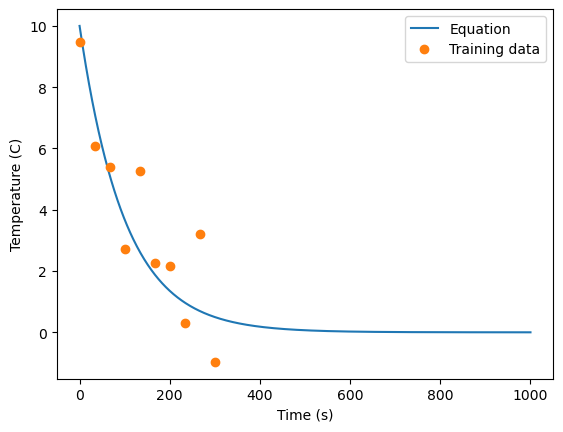
Create a simple neural network
def np_to_th(x): # Convert numpy array to torch tensor
n_samples = len(x)
return torch.from_numpy(x).to(torch.float).to(DEVICE).reshape(n_samples, -1)
def grad(outputs, inputs): # Compute gradient of outputs with respect to inputs
"""Computes the partial derivative of
an output with respect to an input.
Args:
outputs: (N, 1) tensor
inputs: (N, D) tensor
"""
return torch.autograd.grad(
outputs, inputs, grad_outputs=torch.ones_like(outputs), create_graph=True
)
Create a function that:
Design the network
Train the network
Predict
class Net(nn.Module):
def __init__(
self,
input_dim, # Number of input features
output_dim, # Number of output features
n_units=100, # Number of units in hidden layers
epochs=1000, # Number of epochs to train for
loss=nn.MSELoss(), # Loss function
lr=1e-3, # Learning rate
loss2=None, # Second loss function
loss2_weight=0.1, # Weight of second loss function
) -> None:
super().__init__()
self.epochs = epochs
self.loss = loss
self.loss2 = loss2
self.loss2_weight = loss2_weight
self.lr = lr
self.n_units = n_units
self.layers = nn.Sequential( # Define layers
nn.Linear(input_dim, self.n_units),
nn.ReLU(),
nn.Linear(self.n_units, self.n_units),
nn.ReLU(),
nn.Linear(self.n_units, self.n_units),
nn.ReLU(),
nn.Linear(self.n_units, self.n_units),
nn.ReLU(),
)
self.out = nn.Linear(self.n_units, output_dim)
def forward(self, x): # Forward pass
h = self.layers(x)
out = self.out(h)
return out
def fit(self, X, y): # Train the model
Xt = np_to_th(X)
yt = np_to_th(y)
optimiser = optim.Adam(self.parameters(), lr=self.lr) # Optimiser
self.train()
losses = []
for ep in range(self.epochs):
optimiser.zero_grad()
outputs = self.forward(Xt)
loss = self.loss(yt, outputs)
if self.loss2:
# loss += self.loss2_weight * self.loss2(self)
loss += self.loss2_weight + self.loss2_weight * self.loss2(self)
loss.backward()
optimiser.step()
losses.append(loss.item())
if ep % int(self.epochs / 10) == 0:
print(f"Epoch {ep}/{self.epochs}, loss: {losses[-1]:.2f}")
return losses
def predict(self, X):
self.eval()
out = self.forward(np_to_th(X))
return out.detach().cpu().numpy()
net = Net(1,1, n_units=10, loss2=None, epochs=20000, lr=1e-5).to(DEVICE)
losses = net.fit(t,T)
plt.plot(losses)
plt.yscale('log')
Epoch 0/20000, loss: 20.08
Epoch 2000/20000, loss: 18.49
Epoch 4000/20000, loss: 18.30
Epoch 6000/20000, loss: 18.07
Epoch 8000/20000, loss: 17.69
Epoch 10000/20000, loss: 17.22
Epoch 12000/20000, loss: 16.50
Epoch 14000/20000, loss: 15.71
Epoch 16000/20000, loss: 14.75
Epoch 18000/20000, loss: 13.63
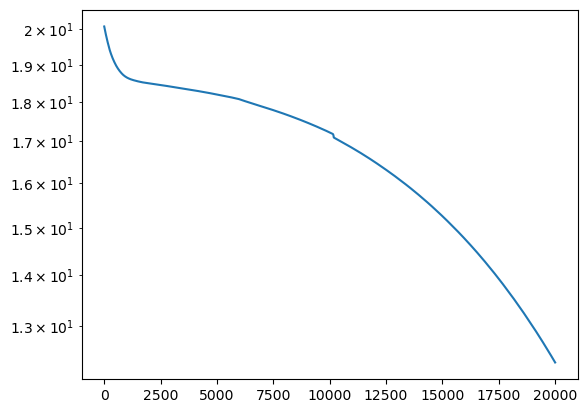
First, we will regularize the training using Ridge Regression of the model by adding the norm of the model weights. We first define an additional loss as the L2 norm of all hidden model parameters.
# define the second loss function as the L2 norm of the weights
def l2_reg(model: torch.nn.Module):
return torch.sum(sum([p.pow(2.) for p in model.parameters()]))
Re-train the model from scratch by minimizing the residual and model loss.
netreg = Net(1,1, n_units=50, loss2=l2_reg, epochs=20000, lr=1e-4, loss2_weight=1).to(DEVICE)
losses2 = netreg.fit(t, T)
plt.plot(losses)
plt.plot(losses2)
plt.yscale('log')
Epoch 0/20000, loss: 1836.45
Epoch 2000/20000, loss: 906.29
Epoch 4000/20000, loss: 448.17
Epoch 6000/20000, loss: 191.89
Epoch 8000/20000, loss: 69.84
Epoch 10000/20000, loss: 29.13
Epoch 12000/20000, loss: 23.03
Epoch 14000/20000, loss: 22.82
Epoch 16000/20000, loss: 22.82
Epoch 18000/20000, loss: 22.82

predsreg = netreg.predict(times)
preds = net.predict(times)
plt.plot(times, temps, alpha=0.8)
plt.plot(t, T, 'o')
plt.plot(times, preds, alpha=0.8)
plt.plot(times, predsreg, alpha=0.8)
plt.legend(labels=['Equation','Training data', 'Network', 'Ridge network'])
plt.ylabel('Temperature (C)')
plt.xlabel('Time (s)')
Text(0.5, 0, 'Time (s)')
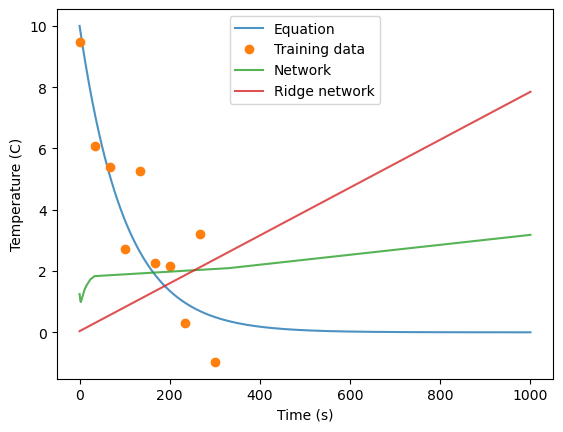
PINN#
We now inform the model training by constraining the predicted output to satisfy the equation of diffusion.
The loss is defined by predicting the output fields on a synthetic time series. Caluclating such loss involves:
create a synthetic input series that is regularly spaced / gridded that goes from 0 to maximal value. We add the function
requires_gradto allow differentiation of the model output with respect to this input field.predict the output field given the synthetic input for each, sorted, input field.
calculate the gradient of the output, given that the output vector is created from incrementally increasing input values.
calculate the residual of the PDE: dT/dt - R()
def physics_loss(model: torch.nn.Module):
ts = torch.linspace(0, 1000, steps=1000,).view(-1,1).requires_grad_(True).to(DEVICE) # Time as torch tensor
# require_grad=True means that we will be able to compute gradients with respect to this tensor
temps = model(ts) # Compute temperatures on the synthetic time input
dT = grad(temps, ts)[0] # Compute the derivative of the temperatures with respect to time
pde = R*(Tenv - temps) - dT # compute the residual of the PDE: dT/dt - R(Tenv - T) = 0
return torch.mean(pde**2)
net = Net(1,1, loss2=physics_loss, epochs=30000, loss2_weight=1, lr=1e-5).to(DEVICE)
losses = net.fit(t, T)
plt.plot(losses)
plt.yscale('log')
Epoch 0/30000, loss: 26.58
Epoch 3000/30000, loss: 5.23
Epoch 6000/30000, loss: 2.07
Epoch 9000/30000, loss: 1.85
Epoch 12000/30000, loss: 1.78
Epoch 15000/30000, loss: 1.74
Epoch 18000/30000, loss: 1.68
Epoch 21000/30000, loss: 1.62
Epoch 24000/30000, loss: 1.54
Epoch 27000/30000, loss: 1.48
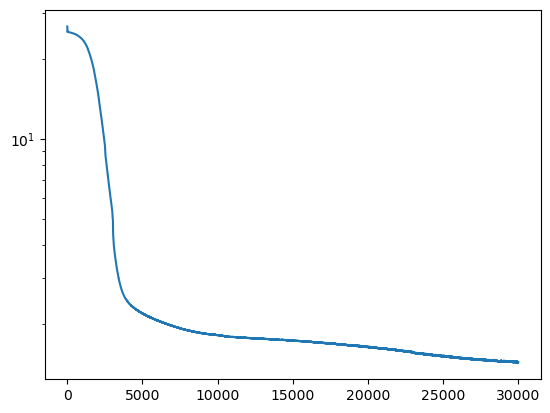
preds = net.predict(times)
plt.plot(times, temps, alpha=0.8)
plt.plot(t, T, 'o')
plt.plot(times, preds, alpha=0.8)
plt.legend(labels=['Equation','Training data', 'PINN'])
plt.ylabel('Temperature (C)')
plt.xlabel('Time (s)')
Text(0.5, 0, 'Time (s)')
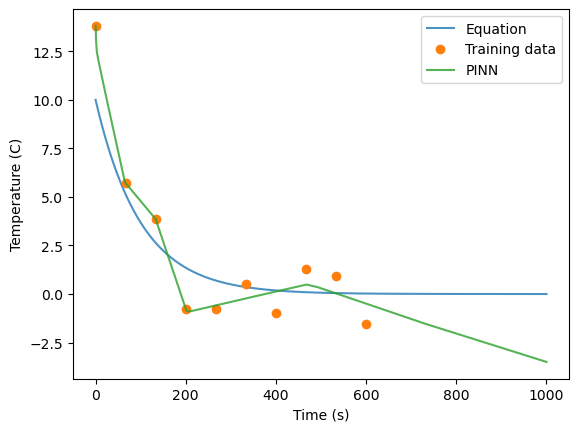
Discover model#
What if we wanted to learn about the learning rate?
We can add the colling/heating rate \(r\) as a parameter.
class NetDiscovery(Net):
def __init__(
self,
input_dim,
output_dim,
n_units=100,
epochs=1000,
loss=nn.MSELoss(),
lr=0.001,
loss2=None,
loss2_weight=0.1,
) -> None:
super().__init__(
input_dim, output_dim, n_units, epochs, loss, lr, loss2, loss2_weight
)
self.r = nn.Parameter(data=torch.tensor([0.]))
We now define the loss function to minimize the physics loss, and adding \(r\) as a model parameter.
def physics_loss_discovery(model: torch.nn.Module):
ts = torch.linspace(0, 1000, steps=1000,).view(-1,1).requires_grad_(True).to(DEVICE)
temps = model(ts)
dT = grad(temps, ts)[0]
pde = model.r * (Tenv - temps) - dT
return torch.mean(pde**2)
netdisc = NetDiscovery(1, 1, loss2=physics_loss_discovery, loss2_weight=1, epochs=40000, lr= 5e-6).to(DEVICE)
losses = netdisc.fit(t, T)
plt.plot(losses)
plt.yscale('log')
Epoch 0/40000, loss: 26.12
Epoch 4000/40000, loss: 12.09
Epoch 8000/40000, loss: 2.50
Epoch 12000/40000, loss: 2.41
Epoch 16000/40000, loss: 2.40
Epoch 20000/40000, loss: 2.40
Epoch 24000/40000, loss: 2.39
Epoch 28000/40000, loss: 2.39
Epoch 32000/40000, loss: 2.39
Epoch 36000/40000, loss: 2.39
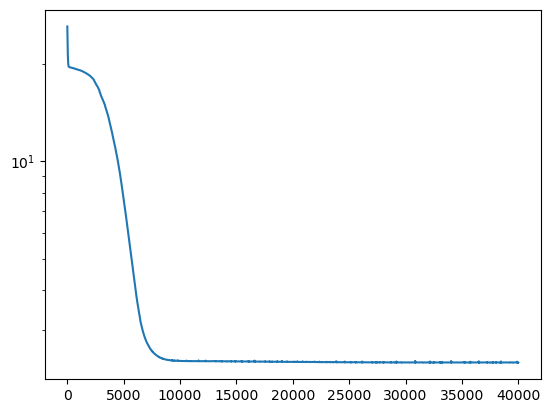
preds = netdisc.predict(times)
print(netdisc.r.item())
plt.plot(times, temps, alpha=0.8)
plt.plot(t, T, 'o')
plt.plot(times, preds, alpha=0.8)
plt.legend(labels=['Equation','Training data', 'discovery PINN'])
plt.ylabel('Temperature (C)')
plt.xlabel('Time (s)')
0.0006263194954954088
Text(0.5, 0, 'Time (s)')
